by Nancy Del Col
When I was teaching high school I would say to my students – who complained about homework, unfair teachers, nonsensical school rules, boring classes – not to take their education for granted, for it was the one thing no one could take away from them. I agreed with Joseph Addison, the 18th century English essayist, who said: “Education is a companion which no misfortune can depress, no crime destroy, no enemy alienate, no despotism enslave.”
Education is a life-long gift, an investment in young minds that pays future dividends in many ways: employment and entrepreneurship opportunities, narrowing of gender inequities, lifting generations out of poverty, inclusion of the excluded, exposure to diverse viewpoints, independent thought, critical-thinking skills, access to information and the ability to make informed life choices.
 Students at this grade 7-12 school in Honduras have the chance to learn auto mechanics, accounting and finance, science and humanities, agroforestry, community development, along with many other skills. Photo: Jon Warren
Students at this grade 7-12 school in Honduras have the chance to learn auto mechanics, accounting and finance, science and humanities, agroforestry, community development, along with many other skills. Photo: Jon Warren
Education is also a fundamental human right, affirmed and protected by the
International Declaration of Human Rights, the
Convention Against Discrimination in Education and the
UN Sustainable Development Goals. Yet increasingly, education is under attack by conflict, war and targeted violence in
at least 35 countries. Contrary to Addison’s viewpoint, education can be depressed, destroyed, alienated and enslaved, often in the name of political and religious agendas.
Education under attack
On September 9, the
UN International Day to Protect Education from Attack, I reflect on the millions of children who live in conflict and crisis-affected contexts, children who cannot attend school because it is simply too dangerous. Children who want to learn, but whose parents and caregivers are afraid to send them to schools that are targets for terrorists, armed jihadist groups, state actors and warring factions shamelessly attacking classrooms, teachers, students, and education systems, to put forward political agendas.
The
statistics are shocking:
- 75 million 3-to-18-year-olds living in 35 crisis-affected countries are affected by attacks on education.
- More than 22,000 students, teachers, and academics were injured, killed, or harmed in attacks on education during armed conflict or insecurity over the past five years.
- Armed forces and armed groups used schools and universities for military purposes in 34 countries between 2015 and 2019, including as bases, detention centers, and weapons stores.
- In the past five years, state armed forces or armed groups reportedly recruited students from schools in 17 countries.
Afghanistan, Palestine, Cameroon, Nigeria, Kenya, Democratic Republic of Congo, Mali, Brazil, Pakistan, Uganda, Yemen. Many of these countries, including Canada, have signed the
Safe Schools Declaration, an inter-governmental commitment launched in 2015 to protect education from attack and military use. However, 2020 saw a global increase in attacks on schools. We read the stories of girls and boys abducted from school dorms and enslaved or ransomed by armed militant groups, schools destroyed by bombs, girls denied access to education, children recruited as soldiers, children and teachers attacked. When schools are closed because of security issues, over and above the added strains of COVID-19 school closures, girls and boys are increasingly at risk, not just from loss of learning, but more critically from recruitment by armed groups, sexual violence, abduction, enslavement, forced labour, and even maiming and killing.
 When he was just 11-years-old, Joseph was abducted by an armed group in South Sudan. “I was made to carry guns during operations, fetched water and food, and tasked to wash the commander's clothes. They beat me every time I resisted. But my worst experience was seeing people killed in my presence," he recalls. Now he's home with his father and they are working to rebuild their lives. Photo: Scovia Faida Charles
Education in Danger’s
When he was just 11-years-old, Joseph was abducted by an armed group in South Sudan. “I was made to carry guns during operations, fetched water and food, and tasked to wash the commander's clothes. They beat me every time I resisted. But my worst experience was seeing people killed in my presence," he recalls. Now he's home with his father and they are working to rebuild their lives. Photo: Scovia Faida Charles
Education in Danger’s monthly news brief reported the following incidents in May 2021 alone:
- separatists kidnapped 11 educators in Cameroon;
- armed forces set fire to schools, a chapel and houses killing six men and a boy in Democratic Republic of Congo;
- three university students, a lecturer and her husband were taken for ransom and 200 students kidnapped by heavily armed bandits in Nigeria;
- a car bomb detonated in front of a school for girls, killing 85 people, mostly teenage female students, and injuring 147 in Afghanistan;
- 102 reported incidents of violence against or obstruction of education since the military coup in February in Myanmar;
- a sixth-grade female student at a middle school in Idaho wounded three people with a handgun in the United States;
- an 18-year-old man armed with a sword attacked a nursery school killing three toddlers in Brazil;
- a school was hit by a drone strike, injuring four children in the playground in Yemen.
Is it any wonder parents, concerned about safeguarding their children, keep them home, with little or no access to continuous education?
How World Vision is responding when education is under attack
Earlier this year, a World Vision supported school in Koro commune in Mali was attacked by armed groups on motorcycles. They broke into the schoolyard, set fire to classrooms and student records, and damaged the head teacher’s office. The attackers, members of a local radical group, are opposed to the traditional French language public school system which they perceive as being against the principles of Islam, teaching Western style thinking in contradiction to Koranic schools or madrasas which teach the Qur’an. This is not an isolated incident. Last year, in nearby communes, an educator was abducted and another school set on fire. These attacks serve as warnings to parents, who then transfer their children to Koranic schools (where girls can only attend to the age of 12 or 13) to protect them.
 Alimatou, 9, and her mother Laya fled armed conflict in their home community in Northern Mali. Now they live in a camp for internally displaced people. Escalating violence in the region has meant that the local school in Alimatou's hometown has been closed for 3 years. Now in the IDP camp, the promise of education is still out of reach. Photo: Fousseni Kone
Alimatou, 9, and her mother Laya fled armed conflict in their home community in Northern Mali. Now they live in a camp for internally displaced people. Escalating violence in the region has meant that the local school in Alimatou's hometown has been closed for 3 years. Now in the IDP camp, the promise of education is still out of reach. Photo: Fousseni Kone
According to Martin Diarra, World Vision Mali’s Education Program Manager, the government authorities condemn these attacks and are relocating students to more secure schools and communes, providing psychosocial support to teachers and working with schools to develop safety and security plans. World Vision is supporting the response of the government by reporting all incidents of attacks on schools and education staff to the Ministry of Education and by using a Community-Based Disaster Risk Management approach which provides training to teachers and students on protection in the event of attacks, training for school management committees on risk management and school safety plans, establishing child protection committees and providing trauma support.
Through a Government of Canada funded project called IMAGINE, World Vision, working in collaboration with Plan Canada, Save the Children Canada and the Mali Ministry of Education, is also reaching out to Koranic schools and educators to support training in children’s rights and gender-sensitive classroom management approaches. In the Malian context of interfaith tensions, Diarra says it is “also necessary to accelerate the process of disarming attackers and undertake awareness activities on themes such as social cohesion, peacebuilding and enforcement of teacher’s capacities in psychosocial support and positive discipline in class.”
The right to safe education for children everywhere
Last weekend I watched a group of children from different ethnic and religious backgrounds play together at a provincial campground, their days of summer freedom soon to be replaced by school timetables. They were catching frogs in the lake, proud to show off their captures, goading each other in friendly competition, girls and boys interacting in fair and equal play, and in the process learning informally about the natural world. Parents, grandparents, and older siblings watched from the beach, calling out mostly ignored instructions to stay distanced from each other.
 Children play at the "Encounters of Hope" child friendly space in northern Colombia, near the border
Children play at the "Encounters of Hope" child friendly space in northern Colombia, near the border
with Venezuela. Children everywhere have the right to a safe place to learn and play. Photo: Alejandro Mendez
In another week, I thought, this same scenario will be happening in school playgrounds. And I thought, how fortunate we are in Canada that our children have access to safe, protected informal and formal education, where our greatest concern is safety from COVID infection, not attack, abduction or destruction. This is what all children, everywhere, deserve. The right to peace, security, acceptance, play and safe places to learn.
Nancy Del Col is an education technical specialist for World Vision Canada. After more than 21 years in the Ontario public school system, Nancy turned her skills as an educator toward supporting children and educators around the world. She is passionate about improving children's lives through child-centred quality instruction, inclusive and equitable access to learning and building literacy and life skills. Nancy holds an MEd in Adult Education and Community Development from OISE at the University of Toronto, a graduate certificate in International Project Management from Humber College, and a BEd from the University of Toronto.